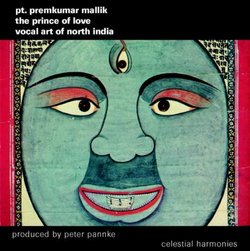| All Artists: Pandit Premkumar Mallik Title: The Prince of Love: Vocal Art of North India Members Wishing: 2 Total Copies: 0 Label: Celestial Harmonies Original Release Date: 10/15/2004 Release Date: 10/15/2004 Genres: International Music, New Age Style: Number of Discs: 1 SwapaCD Credits: 1 UPCs: 0013711323825, 013711323825 |
Search - Pandit Premkumar Mallik :: The Prince of Love: Vocal Art of North India
 | Pandit Premkumar Mallik The Prince of Love: Vocal Art of North India Genres: International Music, New Age
The Prince of Love: Vocal Art of North India is the first co-production between Celestial Harmonies and Rundfunk Berlin-Brandenburg. Dhrupad originated in the 15th century in the pastoral landscape of Braj situated between... more » |
Larger Image |
CD Details
Synopsis
Album Description
The Prince of Love: Vocal Art of North India is the first co-production between Celestial Harmonies and Rundfunk Berlin-Brandenburg. Dhrupad originated in the 15th century in the pastoral landscape of Braj situated between Delhi and Agra, where the blind poet Surdas and his contemporaries had envisioned and re-enacted the childhood of the cowherd god Krishna and his beloved Radha. The rise of dhrupad was the birth of what is called North Indian classical music in modern parlance. Characterised by slow movements and deep registers, dhrupad has always been considered an exclusively masculine art. Moreover, dhrupad is mainly a vocal art; the only instrument which could adequately reproduce the movements and range of a deep male voice was the sonorous rudra vina, an instrument which was said to have been shaped by Shiva itself. Within a very short time, dhrupad and its counterpart dhamar, became so immensely popular that the nawabs and maharajas, the rulers of the country, invited the musicians from their secluded ashrams and temples on the banks of the Jamuna river into their courts. Even if the royal patrons were devout muslims, the content of the songs, telling about Krishna and other gods and godesses, always remained the same. By the 19th century, it had been eclipsed by khyal?a new performance style which allowed the artists more room for showing off their virtuosity. Unknown to Western musicologists, the art of dhrupad had survived in such remote places as Darbhanga in North Eastern Bihar, close to the Nepalese border and in the temples of Varanasi. Shri Amarnathji, the head priest of the Shankat Mochan temple, had the idea to summon all the musicians he knew of to revive the ancient tradition at a festival at Tulsi Ghat. It proved to be a tremendous eye-opener to the few Westerners who gathered there, including Peter Pannke, this recording?s Producer.

 Track Listings (9) - Disc #1
Track Listings (9) - Disc #1